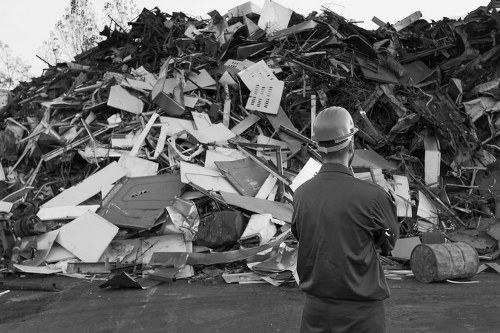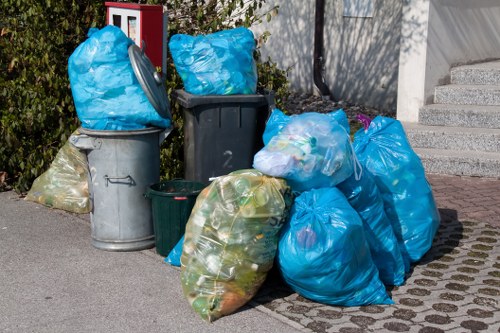Garbage Collection in Commercial Waste Collection

Efficient garbage collection is a cornerstone of effective commercial waste management systems. Businesses across various industries generate substantial amounts of waste daily, making the implementation of a robust garbage collection strategy essential. This article delves into the intricacies of garbage collection in the commercial sector, exploring best practices, innovative technologies, and the environmental impact of waste management.
Commercial garbage collection encompasses the processes involved in the collection, transportation, and disposal of waste generated by businesses. Unlike residential waste management, commercial waste often includes a higher volume and a more diverse range of materials, necessitating specialized handling and disposal methods. Understanding the unique challenges and solutions in this field is crucial for businesses aiming to maintain sustainability and regulatory compliance.
One of the primary considerations in commercial garbage collection is the categorization of waste. Proper sorting not only facilitates recycling but also reduces the overall environmental footprint of a business. By implementing effective waste segregation practices, companies can significantly decrease the volume of waste sent to landfills, promoting a circular economy.
The Importance of Effective Waste Management

Effective waste management is pivotal for businesses aiming to operate sustainably and responsibly. It not only helps in minimizing environmental impact but also contributes to cost savings and enhanced corporate reputation. Proper garbage collection ensures that waste is handled efficiently, reducing the risks of pollution and health hazards associated with improper disposal.
Implementing a structured waste management system can lead to significant economic benefits. By reducing the amount of waste generated, businesses can lower disposal costs and potentially generate revenue through recycling initiatives. Moreover, sustainable waste practices can improve a company's marketability, as consumers increasingly prefer environmentally conscious brands.
Regulatory compliance is another critical aspect of commercial waste collection. Governments worldwide have established stringent regulations governing waste disposal to protect public health and the environment. Adhering to these regulations not only avoids legal penalties but also demonstrates a company's commitment to corporate social responsibility.
Key Components of Commercial Garbage Collection

The commercial garbage collection process comprises several key components, each integral to the overall efficiency and effectiveness of waste management. These components include waste assessment, collection methods, transportation logistics, and disposal techniques.
Waste Assessment: Conducting a thorough waste assessment is the first step in developing a tailored waste management plan. This involves analyzing the types and quantities of waste generated, identifying potential sources of waste reduction, and determining the most suitable recycling and disposal options.
Collection Methods: The choice of collection methods depends on the nature of the business and the types of waste produced. Common collection methods include regular scheduled pickups, on-demand services, and internal waste handling systems such as composting and recycling stations.
Innovative Technologies in Garbage Collection

Advancements in technology have revolutionized the way commercial garbage collection is managed. Innovative solutions such as smart waste bins, automated collection systems, and data analytics are enhancing the efficiency and sustainability of waste management processes.
Smart Waste Bins: Equipped with sensors, smart waste bins monitor fill levels in real-time, enabling optimized collection schedules and reducing unnecessary pickups. This not only conserves resources but also minimizes operational costs.
Automated Collection Systems: Automated systems streamline the collection process by utilizing mechanical arms and conveyors to handle waste, reducing the need for manual labor and improving safety standards in waste handling facilities.
Environmental Impact of Commercial Waste

The environmental impact of commercial waste is substantial, making effective garbage collection imperative. Improper waste management contributes to pollution, greenhouse gas emissions, and the depletion of natural resources. By adopting sustainable waste management practices, businesses can mitigate these negative effects and promote environmental stewardship.
Recycling and reuse are critical strategies in reducing the environmental footprint of commercial waste. By diverting recyclable materials from landfills, businesses can conserve energy and raw materials, fostering a more sustainable economy. Additionally, reducing waste generation through efficient processes and material optimization further diminishes the environmental impact.
Composting organic waste is another environmentally friendly practice that can significantly reduce the volume of waste sent to landfills. Composting transforms organic materials into valuable soil amendments, enhancing soil health and reducing the need for chemical fertilizers in agricultural practices.
Best Practices for Commercial Garbage Collection
Implementing best practices in commercial garbage collection ensures that waste is managed efficiently and sustainably. These practices encompass waste minimization, employee training, regular audits, and the integration of eco-friendly technologies.
Waste Minimization: Reducing the amount of waste generated is the most effective way to lower disposal costs and environmental impact. Businesses can achieve this by optimizing production processes, encouraging the use of reusable materials, and implementing strict purchasing policies to avoid excessive packaging.
Employee Training: Educating employees about proper waste segregation and disposal procedures is crucial for the success of a waste management program. Regular training sessions can enhance compliance and foster a culture of sustainability within the organization.
Regular Audits and Monitoring
Conducting regular audits and monitoring waste management practices helps identify areas for improvement and ensures compliance with regulatory standards. These audits can reveal inefficiencies in the waste collection process, enabling businesses to make informed decisions and implement necessary adjustments.
Monitoring systems, such as real-time tracking of waste collection activities and data analysis, provide valuable insights into waste generation patterns. This information can be used to optimize collection routes, schedule pickups more effectively, and allocate resources where they are most needed.
Utilizing data-driven approaches enhances the overall effectiveness of waste management strategies, allowing businesses to achieve higher levels of sustainability and operational efficiency.
Integration of Eco-Friendly Technologies
Integrating eco-friendly technologies into commercial garbage collection systems can significantly enhance sustainability efforts. Technologies such as electric waste collection vehicles, renewable energy-powered facilities, and advanced recycling machinery contribute to reducing the environmental impact of waste management operations.
Electric waste collection vehicles offer a cleaner alternative to traditional diesel-powered trucks, decreasing greenhouse gas emissions and lowering noise pollution. Additionally, renewable energy sources, such as solar and wind power, can be utilized to operate waste management facilities, further minimizing the carbon footprint.
Advanced recycling machinery improves the efficiency and effectiveness of material recovery processes, ensuring that a higher percentage of waste is diverted from landfills and repurposed for new uses.
Challenges in Commercial Garbage Collection

Despite advancements in waste management technologies and practices, commercial garbage collection faces several challenges. These include managing diverse types of waste, ensuring compliance with ever-evolving regulations, and addressing the logistical complexities of large-scale waste operations.
Diverse Waste Streams: Commercial establishments generate a wide array of waste, including hazardous materials, recyclables, organic waste, and general refuse. Effectively managing these diverse streams requires specialized handling and disposal procedures to prevent contamination and ensure environmental safety.
Regulatory Compliance: Navigating the complex landscape of waste management regulations can be daunting for businesses. Staying abreast of changes in legislation and ensuring adherence to all relevant standards is essential to avoid legal repercussions and maintain operational legitimacy.
Strategies to Overcome Challenges

To overcome the challenges associated with commercial garbage collection, businesses can adopt several strategies. These include leveraging technology, fostering partnerships with waste management experts, and continuously improving waste management protocols.
- Technology Adoption: Implementing smart waste management systems can help streamline operations, improve tracking, and enhance overall efficiency.
- Partnerships: Collaborating with experienced waste management service providers ensures access to specialized knowledge and resources.
- Continuous Improvement: Regularly reviewing and updating waste management practices helps businesses stay aligned with best practices and regulatory requirements.
By proactively addressing these challenges, businesses can maintain effective garbage collection systems that support sustainability goals and operational efficiency.
The Future of Commercial Garbage Collection

As sustainability becomes increasingly important, the future of commercial garbage collection is poised for significant transformation. Emerging trends such as circular economy models, increased automation, and greater emphasis on sustainability metrics are shaping the evolution of waste management practices.
Circular Economy Models: Transitioning to a circular economy involves designing waste out of the system and promoting the continual use of resources. In commercial garbage collection, this means prioritizing reuse, recycling, and recovery to minimize waste generation and maximize resource efficiency.
Increased Automation: Automation technologies are expected to play a larger role in waste collection, enhancing precision and reducing labor costs. Automated sorting systems and robotic waste handlers can improve the accuracy and speed of waste processing, contributing to more efficient operations.
Sustainability Metrics and Reporting

Measuring and reporting sustainability metrics is becoming a standard practice in commercial waste management. Businesses are increasingly required to quantify their environmental impact and demonstrate progress toward sustainability goals. Key metrics include waste diversion rates, recycling percentages, carbon footprint, and resource consumption.
Implementing robust tracking systems enables businesses to collect accurate data, which can be used to inform decision-making and drive continuous improvement. Transparent reporting of these metrics not only fulfills regulatory requirements but also enhances stakeholder trust and supports corporate sustainability initiatives.
Adopting comprehensive sustainability reporting frameworks ensures that businesses can effectively communicate their waste management performance to customers, investors, and other stakeholders.
Conclusion
Garbage collection in commercial waste management is a complex yet vital aspect of sustainable business operations. By understanding the key components, embracing innovative technologies, and implementing best practices, businesses can effectively manage their waste, reduce environmental impact, and achieve cost savings. As the landscape of waste management continues to evolve, staying informed and adaptable is essential for long-term success and environmental stewardship.
Contact us today to learn more about optimizing your commercial garbage collection processes and enhancing your sustainability efforts.